The x86 Power Myth Busted: In-Depth Clover Trail Power Analysis
by Anand Lal Shimpi on December 24, 2012 5:00 PM ESTIdle Power
In all of these tests you're going to see three charts. The first will show you total platform power, measured at the battery, taking into account everything from SoC to display. The next shows you power measured at the CPU power delivery circuit, and the third shows you power measured at the GPU power delivery circuit. All values are measured in watts, and are reported in 15ms intervals (although I sampled at 1KHz then averaged down to 15ms).
For our first set of tests I simply wanted to get a feel for idle power. Both systems had all background syncing suspended, WiFi was connected, and we're just sitting at the Windows RT/8 Start Screen until the tablets reached a truly idle state. Note that idle under Windows RT/8 technically doesn't happen until the live tiles stop updating, which you'll see denoted by a drop in the idle power consumption in the graphs below.
First up is total platform power consumption:
Surface RT has higher idle power, around 28% on average, compared to Acer's W510. The last half of the graph shows the tablets hitting true idle when the live tiles stop animating.
A look at the CPU chart gives us some more granularity, with Tegra 3 ramping up to higher peak power consumption during all of the periods of activity. Here the Atom Z2760 cores average 36.4mW at idle compared to 70.2mW for Tegra 3.
The GPU specific data is pretty interesting - the GPU power rail shows much high power consumption than on Intel's Z2760. As I didn't design Tegra 3, I don't know what else is powered by this rail - although you'd assume that anything else not in use would be power gated. Imagination Technologies' PowerVR SGX 545 does appear to be quite power efficient here, on average using 155mW while rendering the Start Screen.
I wasn't happy with the peaks we were seeing when nothing was happening on the systems, so to confirm that nothing funny was going on I threw both tablets into airplane mode and waited for full idle. Check out the tail end of the platform power diagram:
That's much better. Without the AP talking to each tablet's WiFi radio constantly, idle becomes truly idle. If you're curious, the power savings are around 47.8mW (average) for the W510 in airplane mode when fully idle.
The GPU rail feeding the Atom Z2760 appears to hit a lower idle power when compared to NVIDIA's Tegra 3. Advantages in idle power consumption are key to delivering good battery life overall.


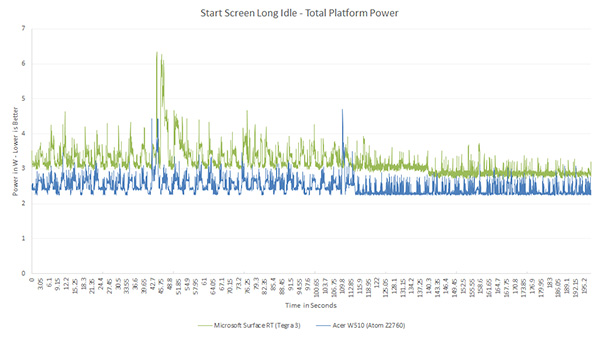
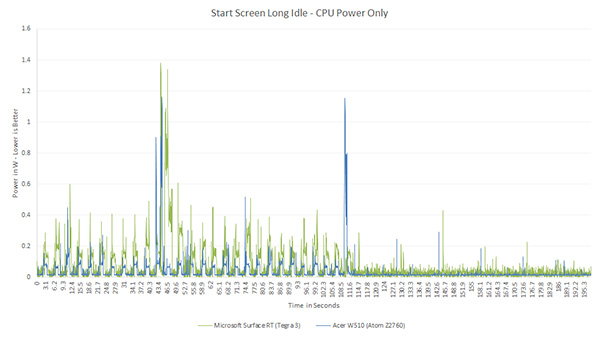
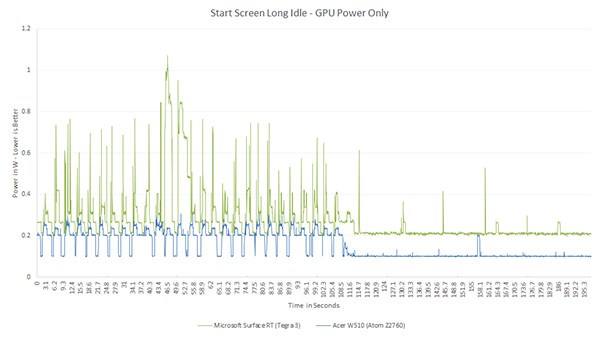

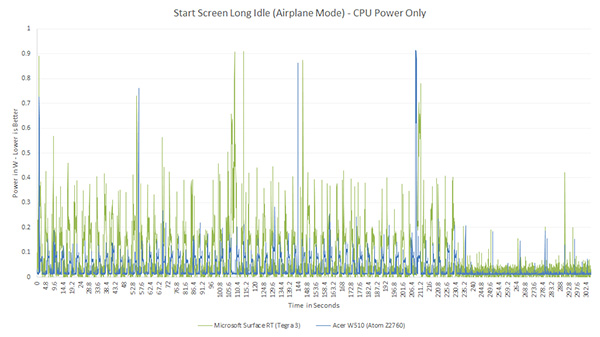
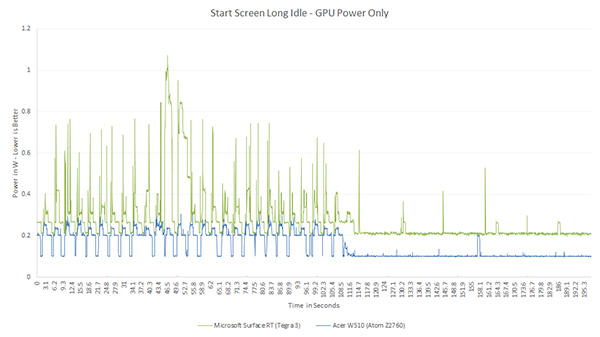








163 Comments
View All Comments
snoozemode - Monday, December 24, 2012 - link
The difference this time is huge compared to competitors Intel has faced in its history. Its not just about specs anymore, no matter if its performance or performance per watt, its a lot more about economy and margins. Anyone with an ARM license can build a SoC and a lot of new players are coming to the game, especially from China. And players like Samsung who produces own SoCs for their own devices, soon LG and possibly Apple aswell means that the days of Intel dictating the terms and dominating the industry is just not going to happen this time.KitsuneKnight - Monday, December 24, 2012 - link
You mean it's much closer to Intel's early days, when it faced dozens of competing companies, instead of just a couple tiny ones.snoozemode - Tuesday, December 25, 2012 - link
Still very different because of ARMs business model which is nothing like the past with Intel, AMD, Cyrix, IBM etc. Intel definitely didn't became the giant it is because of products with good value. They are what they are because of continously raising the bar above everyone else from a performance standpoint at a time when performance was everyting and energy efficiency was close to nothing. And when they sometimes have failed to compete from a performance standpoint (ex AMD around 2000) they have resorted to some serious foul play.ay@m - Thursday, December 27, 2012 - link
well, what if Intel is now measuring the energy efficiency as the new performance benchmark?that's exactly what this article is pointing out, that Intel's Atom chip is starting to focus on energy efficiency and not focusing on the performance anymore...right?
so i think Intel understands now what it takes to enter the mobile market and what the end user will perceive as the new performance benchmark.
Kidster3001 - Friday, January 4, 2013 - link
You make Intel's point!Intel will continue to have the performance advantage. They are now going after the power part of the equation. When they are best at both (or at least significantly better at one and same at the other) what do think the result will be?
Kevin G - Tuesday, December 25, 2012 - link
The problem for Intel is that they'll design the SoC that they want to manufacture and not necessarily what the OEM wants. Intel could over spec an SoC to cover a broader market but at an increased die size and power consumption. Intel's process advantage mitigates those factors but they'll still be at a disadvantage compared to another SoC designer that'll make a product with the bare necessary functional blocks. For Intel to become a major mobile player, they'll have to start listening to OEM's and designing chips specific to them.yyrkoon - Tuesday, December 25, 2012 - link
Intel already is a major player in the mobile market. They have been far longer than anyone producing ARM based processors.Granted according to an article I read a few months back. Tablet / smart phone sales are supposedly eclipsing the sales of laptops, and desktops combined. whether true or not, I can see it being possible soon, if not already.
p3ngwin1 - Tuesday, December 25, 2012 - link
yep, it's also about PRICE.if you've seen the price of the cheap Android tablets and devices, you know Intel will have to either convince us we need to pay a premium for the extra battery-life and performance, or they're going to have to lower their prices to compete aggressively.
you can buy decent SoC's from Allwinner, Rockchip, Nvidia, Qualcomm, etc that deliver "good enough" specs and a decent price, while Intel charges a premium for it's processors.
those cheap China SoC's like Rockwell and Allwinner, etc are ridiculously cheap and you can get Android 4.1 Tablets with 1.6Ghz dual-core ARM A9 processors with Mali400 GPU's and 7" 1200x720 screens for less than $150.
Intel charges way more for their processors compared to the ARM equivalents.
name99 - Tuesday, December 25, 2012 - link
The price issue is a good point.A second point is to ask WHY Intel does better in this comparison. I'd love to see a more detailed exploration of this, but maybe the tools don't exist. However one datapoint we do know is this
(a) SMT on Atom is substantially more effective than on Nehalem/SB/IB. Whereas on the desktop processors it gets you maybe a 25% boost (on IB, worse on older models), on Atom it gets you about 50%. (This isn't surprising because Atom's in-order'ness means there are just that many more execution slots going vacant.)
(b) SMT on Atom (and IB and SB, not on Nehalem) is extremely power efficient.
So one way to run an Atom and get better energy performance than CURRENT ARM devices is to be careful about using only one core, dual threaded, for as long as you can (which is probably almost all the time --- there is very little code that makes use of four cores, or even two cores both at max speed).
I bring this up because this sort of Intel advantage is easily copied. (I'm actually surprised it hasn't already been done --- in my eyes it's a toss up whether Apple's A7 will be a 64-bit Swift or a Swift with SMT. There are valid arguments either way --- it's in Apple's interests to get to 64-bit and a clean switchover as fast as possible, but the power advantages in SMT are substantial, since you can keep your second core asleep so much more often.)
Once you accept the value of companion cores it becomes even more interesting. One could imagine (especially for an Apple with so much control over the OS and CPU) a three-way graduated SOC, with dual-core OoO high performance cores (to give a snappiness to the UI), a single in-order SMT core (for work most of the time), and a low-end in-order core (for those long periods of idle punctuated by waking up to examine the world before going back to sleep). The area costs would be low (because each core could be a quarter or less of the area of its larger sibling; the real pain would be in writing and refining the OS smarts to use such a device well. But the payoff would be immense...
Point is --- I wouldn't write off ARM yet. Intel has process advantages, and some µArch advantages. But the µArch advantages can be copied; and is the process advantage enough to offset the extra cost (in dollars) that it imposes?
Kidster3001 - Friday, January 4, 2013 - link
big.LITTLE is a waste of time. It is a stop-gap ARM manufacturers are using to try and keep the power down. As they increase performance they are not able to keep power in the envelopes they thought they could. It is far more efficient to have cores that are capable of filling all the roles you suggest by dynamically changing how they operate. This is where Intel will succeed, just look at what Haswell can do.